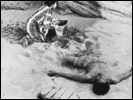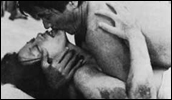Woman in the Dunes
- Year
- 1964
- Original title
- Suna no Onna
- Japanese title
- 砂の女
- Director
- Cast
- Running time
- 123 minutes
- Published
- 20 March 2001



by Jasper Sharp
Born in 1924, Kobo Abe was considered to be one of Japan's foremost living novelists, his Kafka-esque metaphysical musings on the human condition formed the basis of a number of director Hiroshi Teshigahara's films, starting with his debut Pitfall (Otoshiana, 1962). Woman in the Dunes concerns an entomologist (Eiji Okada) on a bug-hunting quest who, after missing his bus back to the city, finds himself stranded in a barren and remote desert region. After accepting the offer of a local villager of a bed for the night, he is lowered down by rope ladder into a large sandpit containing a ramshackle hut. The sole other occupant is a woman (Kyoko Kishida) who spends the night filling sacks with the sand that pours through cracks in the ceiling and walls, and hoisting them out of the pit the following morning.
When the man discovers that the rope ladder is missing, the woman explains that he has been inducted to help her after own husband and son were recently buried beneath a sand slide. The village consists of a row of such houses whose occupants strive continuously to stop the shifting sand from overwhelming them. If one household stops digging, the neighbouring one will suffer too, setting in line a chain reaction that will destroy the entire village. The village survives by exporting the by-product of all this activity to the outside world for construction purposes. In the following weeks, as the man's attempts at escaping this fruitless existence prove futile, he begins to find himself increasingly absorbed by this unsophisticated woman upon whom his survival depends.
Woman in the Dunes was made in the year of the Tokyo Olympics (a documentary of which, Tokyo Olympiad, made by Kon Ichikawa, was released in 1965), a time when the eyes of the world were all on Japan. After defeat in the war and the subsequent US occupation, the economic boom of the mid-1960s turned Japan's fortunes around, making it one of the world's most affluent nations. This rapid modernisation is reflected in the films and literature of the period (cf. the Japanese New Wave cinema spearheaded by Oshima) and Woman in the Dunes can undoubtedly be read as a comment or critique of this time of great social and ideological change.
The purpose behind Woman in the Dunes, which won a Special Jury Prize at Cannes and two Oscar nominations (for Best Director and Best Foreign Film) is not entirely clear. Is Abe's book an allegory of how society, once freed from the burden of merely existing, begins to focus more on the irrelevant minutiae of life? The outsider from the sophisticated big city spends his free time peering at beetles, hoping to dedicate his name to a new species in order to be remembered for posterity. To find himself trapped in an existential void where he must either dig or die represents the ultimate nightmare scenario for a character who has hitherto existed solely thanks to the collaborative efforts of others. Such ideas are never rendered explicitly in either film or novel, posing a lot of tantalising questions for the individual viewer to ponder over.
In any case, this darkly beautiful and hypnotic tale works perfectly well if merely taken on a purely aesthetic level: the most immediate and striking thing about it is its look. Filmed in high-contrast monochrome with large portions of the screen plunged into complete darkness, each shot is formally composed often to the point of pure abstraction. Long static shots of the natural patterns formed in the arid landscape by the wind segue into shots of the undulating contours of the nameless woman's gritty body as she tosses and turns in her sleep. The sensation of sand as a fluid, constantly shifting dynamic entity is all-pervading and captures the spirit of Abe's thoroughly readable novel admirably. As a material caught somewhere between the state of a fluid and a solid, it is depicted pouring through the cracks in the roof, or carried in great drifting clouds by the wind in the desert outside.
Complemented by the sparsely used, minimalist soundtrack courtesy of Toru Takemitsu, Woman in the Dunes is a powerful piece of work, and all produced on a reported paltry $100,000 budget. For all its strengths though, at over two hours in length its leisurely pacing is not going to prove for all tastes.
Teshigara, a high-art aesthete if ever there was one, has often been accused of indulgence, by critics both inside and outside of Japan. The son of a famous flower arranger, after an early career as a painter he worked as an assistant on a number of documentary shorts about A-bomb survivors before forming his own production company in 1961. After a trickle of films in the 60s including another Abe adaptation, The Face of Another (Tanin no Kao, 1966; also featuring the two main actors from this film), he faded away from the big screen for 20 years (a documentary on the Catalan architect Antonio Gaudi in 1984 notwithstanding) before returning in 1989 with Rikyu, a gruellingly long dramatisation of the traditional Japanese tea ceremony. In 1992 he put Nippon media babe Rie Miyazawa (of Koji Wakamatsu's Erotic Liaisons infamy) in the centre of the lavish historical epic Princess Go (Go-hime), his last film before his death in 2001.